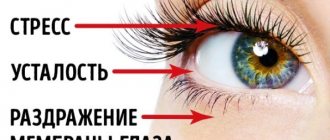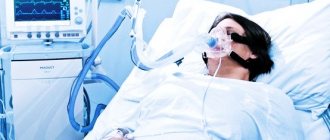Pain Treatment Center
Alekseeva
Oksana Alexandrovna
23 years of experience
Doctor, highest qualification category, member of the European Association of Neurologists, Russian Interregional Society for the Study of Pain (ROIB), Association of Interdisciplinary Medicine. Has experience working in hospital and outpatient services. He has seven published works on neurology.
Make an appointment
The term “neurosis” is usually used to designate a whole group of pathologies, which are based on temporary reversible mental disorders caused by excessive load on the basic nervous processes - excitation and inhibition. Neuroses are functional diseases that are not based on structural disorders. They arise as a result of a severe conflict within the individual or changes in particularly significant life relationships of a person and are manifested by exclusively mild neurotic symptoms and somato-vegetative deviations.
According to academician V.P. Pavlov, neurosis is a breakdown of higher nervous activity that occurs when the normal course of basic nervous processes, their relationships, strength and mobility changes. That is, this is a violation of higher nervous activity and neurovegetative functions, developing under the influence of mental trauma or prolonged emotional stress. It manifests itself primarily in the emotional sphere, while the state of affect provokes changes in thinking and general behavior.
This condition lasts from several days to several years. At the same time, the patient maintains a critical attitude towards the disease, there are no violations of social adaptation. People with melancholic and choleric types of temperament are more likely to suffer from neuroses, while sanguine and phlegmatic people suffer from them much less often.
A characteristic feature of all neuroses is the fact that a person is often aware of the meaninglessness of his symptoms (panic, fear, etc.) or the absence of grounds for somatic symptoms, but still feels anxiety associated with them. It is the patient's criticism of his symptoms that distinguishes neuroses from psychoses.
It should be noted that in the 10th edition of the International Classification of Diseases (ICD-10), the word “neurosis” is not used, and the dominant symptomatology became the basis for the classification of the corresponding group of mental diseases. Thus, some traditionally neurotic disorders belong to “eating disorders”, others to “sleep disorders of an inorganic nature”, etc.
But, despite the fact that the concept itself is gradually disappearing from the terminology of clinical diagnostics, it still remains widely used in psychological practice and the theoretical works of many authors. The concept of neurosis is still useful today when constructing a strategy for psychological support in the psychological service system.
The concept of neurosis unites a whole group of mental disorders with very different symptoms from all organs and systems. This includes a set of psychogenic, emotional and physiological disorders.
Symptoms and signs
Neuroses are characterized by dynamic and varied psychopathological and somatic symptoms against the background of insufficient mental defense. This is accompanied by the formation of a conflict, manifested by disturbances in different areas (emotional, vegetative, endocrine, etc.). There are main groups of clinical symptoms inherent in all types of neuroses, this includes disorders from:
1. self-control:
- discomfort;
- headache;
- feeling of weakness (especially after sleep);
- increased fatigue;
- decreased ability to work;
- prostration.
2. emotions:
- changeability (lability) of mood, irritability;
- tendency to depressive reactions, fears, obsessive concerns;
- violent affective outbursts followed by exhaustion;
- inadequacy of the emotional reaction to the strength of the stimulus;
- lack of control over emotions.
3. volitional sphere and drives:
- loss of appetite;
- sexual function;
- obsessive urges and actions;
- insufficient control of behavior.
4. somatovegetative system:
- hyperhidrosis (excessive sweating), hot flashes;
- increased dermographism (change in skin color, rash);
- tachycardia (rapid heartbeat), changes in blood pressure and pulse;
- constipation, nausea;
- frequent urination, enuresis;
- stuttering;
- tremor (shaking) of the body.
With each type of neurosis, especially its manifestation (vivid manifestation), an arbitrary number of the above symptoms may occur. In the process of further development of the disease, depending on personal characteristics, violations of mental or somatovegetative functions come to the fore.
The development of a certain type of disease significantly depends on the type of higher nervous activity (HNA). Individuals with an artistic type, in whom the first signaling system (subcortical processes) dominates the second (cerebral cortex), often experience hysterical neurosis. Individuals with the mental type GND are prone to obsessive-compulsive neuroses when the second signaling system prevails over the first. Most people have a mixed type of GND; most often they experience neurasthenia.
Are you experiencing symptoms of neurosis?
Only a doctor can accurately diagnose the disease. Don't delay your consultation - call
Symptoms of neuroses in adults
People suffering from such diseases suffer from mood swings, uncertainty (including in their actions), and overreact even to minor stress. In addition, neuroses are manifested by vulnerability, irritability, excessive self-criticism and fixation on the problem, unfounded anxieties, decreased concentration, conflicting desires, severe mental fatigue, etc. Patients are very sensitive to external stimuli. They often suffer from insomnia.
Symptoms include:
- cardiopalmus;
- dry mouth;
- trembling in hands;
- digestive problems;
- hyperemia/pallor of facial skin;
- sweating;
- increased salivation;
- dizziness;
- blood pressure surges;
- headache;
- chills/feeling hot, etc.
Neurasthenia
It is characterized by the presence of diverse symptoms: somatic, neurological, psychopathological. Somatic symptoms are not associated with any disease of the internal organs, but are often so pronounced that they force the patient to constantly contact the appropriate doctors. Mainly observed manifestations of dysfunction of the cardiovascular system, tachycardia, sometimes slowing of the pulse, a feeling of pain, freezing or compression in the heart area. Sometimes there is dysfunction of the digestive tract: decreased or “crankiness” of appetite, nausea, upset stool. With neurasthenia, the symptoms of neurosis in women are expressed by abnormalities in the menstrual cycle. Neuroses in men are characterized by signs of impotence (various forms of impaired sexual desire and erection).
Common symptoms include hyperesthesia (increased sensitivity) to external stimuli (light, sound, etc.), poor health, which is difficult for patients to describe. There is a feeling of heaviness in the head (“cloudy head”), headache of undetermined localization, and dizziness. There are problems with sleep: falling asleep takes a long time, frequent awakenings, sleep is not deep enough, which means it does not bring pleasure and a feeling of rest, even if its duration is sufficient.
The neurological status shows increased tendon reflexes, tremor of extended limbs, severe sweating and other signs of irritation of the autonomic nervous system.
The psychopathological symptoms of neurasthenia are well described by the term “irritable weakness” - increased excitability is combined with rapid fatigue. A bad mood and emotional lability are inherent, which, unlike that in hysteria, is accompanied by rapid depletion of nervous processes. Emotional “explosions” begin easily, due to an insignificant reason. After them, the patient begins to repent of his behavior and feel awkward. Tearfulness is typical, even for neuroses in men, and imbalance when communicating with others. Working capacity, in particular mental, is reduced, but often a person, under the influence of tonic mental factors, can “pull himself together” and complete the required amount of work.
With neurasthenia there are no qualitative intellectual impairments. Patients complain of forgetfulness, poor memory in everyday life, and worry about this. Such manifestations are the consequences of impaired attention and poor concentration, but they pass without a trace.
There are two forms of neurasthenia: hypersthenic and hyposthenic. Hypersthenic is characterized by a predominance of symptoms of irritable weakness, and hyposthenic is characterized by asthenia of the nervous system (general weakness, lethargy, intolerance to any irritants and stress, decreased vitality).
Neuroses
2261 02 September
IMPORTANT!
The information in this section cannot be used for self-diagnosis and self-treatment.
In case of pain or other exacerbation of the disease, diagnostic tests should be prescribed only by the attending physician. To make a diagnosis and properly prescribe treatment, you should contact your doctor. Neuroses: causes, symptoms, diagnosis and treatment methods.
Neuroses, or neurotic disorders, include psychogenic, functional, reversible disorders that tend to last a long time, caused by changes in mental state and disruption of the autonomic nervous system.
That is why such conditions are often referred to as psychosomatic disorders (health problems associated with psycho-emotional experiences) or vegetative-vascular dystonia (a syndrome characterizing autonomic dysfunction). Patients with neurotic disorders are characterized not only by complaints of anxiety and depression, but also by symptoms of somatic diseases - palpitations, a feeling of a coma in the esophagus, pain and dyspeptic symptoms. With neuroses, sleep is disturbed, tearfulness, irritability, constant fatigue and muscle tension appear.
However, unlike true somatic diseases, these symptoms are not constant, since at different times some disappear while others appear.
In the initial stages, treatment of neuroses can be very effective, so it is important to notice them in time.
Causes of neurotic disorders
Despite the vegetative manifestations of neuroses, they are most often based on psychogenic disorders. Various stressful situations and conflicts affect the activity of the nervous system, but normally a person’s adaptive capabilities allow him to recover.
But if a person is predisposed to mental disorders due to heredity, upbringing, ethnic factors, etc., the reaction to stress may exceed adaptive capabilities and be accompanied by a nervous breakdown.
In many ways, the tendency to neurotic disorders is due to a disruption in the interaction of the cortical and subcortical structures of the brain, the signs of which may be greater suggestibility, weakness of will, and affectation (unnatural excessive excitement). For every person there is a limit to adaptation capabilities. Some people can endure mental stress for a long time, while others only need short-term experiences to break down. However, in the presence of additional factors, such as somatic diseases, physical stress, injuries, taking certain medications (corticosteroids; bronchial dilators used for asthma; drugs affecting thyroid function, antihypertensive - blood pressure-lowering drugs, etc. .), as well as with alcohol and drug abuse, the risk of neurotic disorders can significantly increase.
Classification of neurotic disorders
Neurotic disorders can take the forms of asthenic (neurasthenia), hysterical, motor and depressive neuroses (neurotic depression), obsessive-compulsive neurosis.
Neurasthenia is characterized by a combination of increased excitability and fatigue.
Depending on the predominance of one of the symptoms, hypersthenic (irritable) and hyposthenic (depressive) forms of neurasthenia are distinguished.
Hysteria is a more complex form of neurosis, which is based on the desire to attract attention. Women are more susceptible to this disease. Obsessive-compulsive neurosis is manifested by a disturbance in the sphere of volitional and emotional impulses and various fears (phobias). Phobic disorders can be caused by fear for health (fear of getting infected, fear of dying - thanatophobia), fear of being in a crowd (demophobia), or a closed space (claustrophobia). Fears can be accompanied by panic attacks, generalized anxiety and mixed anxiety-depressive disorders. In some cases, autonomic neurosis is identified, which is accompanied by a selective effect on any system of the body (most often the cardiovascular or digestive).
Symptoms of neurotic disorders
Patients with neurasthenic disorders more often complain of symptoms from internal organs, noting sleep disturbances, headaches and muscle pain, constipation or dyspepsia, palpitations, and “fading” of the heart.
Any event can provoke excitement and tearfulness. It is difficult for the patient to concentrate and engage in intellectual activity for a long time. The mood is constantly changing, joyful excitement quickly gives way to depression. Characteristic complaints about symptoms from internal organs against the background of a traumatic situation, which are accompanied by the absence of organic changes.
Hysterical neurosis initially occurs against the background of a conflict situation or an insoluble problem, but in the future its manifestations may not be associated with physical and psychological factors. Movement disorders against the background of a hysterical attack allow the patient to get out of a traumatic situation. Seizures in some cases can result in hysterical amnesia (memory loss). With obsessive states, patients constantly doubt the correctness of actions and try to create a stereotype of behavior (rituality of actions).
During panic attacks, against the background of fear for health, the pulse may increase significantly, chills, sweating, a feeling of lack of air, pain and discomfort in the left half of the chest may appear.
Depressive neurosis is accompanied by constant despondency, mental and motor passivity. Such patients always have low self-esteem. Generalized anxiety disorder is characterized by long-term complaints of at least three of the symptoms listed above: a feeling of constant agitation, sleep disturbances, increased fatigue, irritability and decreased concentration.
Diagnosis of neurotic disorders
Since complaints about somatic disorders come to the fore, diagnosing neuroses is difficult.
Therapists and specialists face a difficult task: to compare complaints about disturbances in the functioning of internal organs and the lack of real changes during examination.
In this case, it is necessary to exclude the first manifestations of mental and somatic diseases. For differential diagnosis, a number of laboratory and instrumental studies are required: a general and biochemical blood test, and for heart complaints, an EEG at rest and during physical activity.
Obsessive-compulsive disorders (OCD)
They are demonstrated by a feeling of fearfulness, intimidation, and anxiety. Obsessive thoughts haunt the patient against his wishes and will, although they are assessed by him as meaningless and harmful. There are syndromes of the following obsessive states:
- doubts – uncertainty about the correctness of actions taken or not taken, contrary to logical arguments. Such a person doubts whether he turned off electrical appliances, closed the door, whether the document was written correctly, etc., although he has repeatedly checked the action performed;
- Memories are annoying pictures of the past. Often a sad, unpleasant or shameful incident for the patient, and he tries not to think about it;
- imagination - the emergence of implausible images, perceived as real despite their absurdity. There may be a belief that the buried relative was alive, or other similar misconceptions. In this case, the patient imagines and painfully experiences the suffering of the “obviously dead” person in the grave or other unpleasant feelings;
- drive - a desire to carry out some extremely undesirable action, accompanied by horror and panic due to the impossibility of freeing oneself from such a desire. For example, it covers the desire to harm a loved one, throw yourself under a train, a car, or push someone under it. At the same time, an unbearable fear is experienced that this is happening (contrasting attraction);
- phobias (fears) - an unreasonable fear of heights, open or confined spaces, crowds of people, sudden death, etc. Sometimes they are accompanied by rituals - monotonous actions that have the meaning of spells and amulets. Such actions are performed with the aim of protecting against a certain misfortune, despite the critical attitude towards them. So, by walking around the arch, instead of passing under it, a person seems to be saving his relatives from harm; when starting something, he snaps his fingers twice or says the “cherished” word out loud - in order to avoid failure.
Some obsessive actions fill the patient’s thoughts until they are implemented, others pass and are forgotten. To keep himself from becoming obsessed, he needs to constantly monitor himself, which is extremely tiring for him.
Close to obsessional neurosis in clinical terms are psychasthenia and psychasthenic neurosis. They are characterized by:
- predominance of asthenia (enduring fatigue, weakness);
- constant general feeling of tension with heavy foreboding;
- conviction of personal social inadequacy, ugliness and inferiority relative to others;
- excessive impressionability due to criticism addressed to oneself;
- reluctance to make contact without a guarantee of being liked;
- avoidance of social or professional activities associated with significant social contacts due to fear of criticism, disapproval, or ignorance;
- limited life and social way of life due to the need for physical and psychological safety.
Differential diagnosis is necessary to distinguish obsessional neurosis from schizophrenia, cerebral atherosclerosis, and the consequences of encephalitis. The distinctive feature of neurosis, and at the initial stage the only psychopathological symptom, will be obsession. There are no intellectual disorders. If the disease takes a long course and is not sufficiently treatable, it can affect the patient’s personality and his future fate.
Hysterical neurosis
The clinical picture of hysteria is characterized by increased lability of emotions and the transition of the mental component to the somatoneurological one. This is the only form of neurosis when qualitative changes in consciousness are possible. Almost all symptoms of hysteria are protective for the patient, corresponding to a specific psychotraumatic situation. They bring a certain moral benefit to the individual, since they provide an opportunity to get rid of another difficult experience. Therefore, hysteria can be considered as a kind of protective phenomenon that occurs under the influence of a super-powerful stimulus.
Example: a mother received unexpected news about the tragic death of her son; while waiting for the body to be brought, she thought with horror that she would not be able to see him dead, and suddenly became blind; After a while, the hysterical blindness passed.
Emotional lability during hysteria manifests itself in a sharp change in emotions and their inconstancy. But, unlike neurasthenia, they are indicated by high intensity and duration. The patient, who a minute ago was crying bitterly and in deep despair, without much effort not only calms down, but also easily comes into a good mood. Such lability of emotions leads to instability in desires, intentions, behavior, likes and dislikes. In addition to emotional lability, a clear symptom of hysteria is easy suggestibility - both self-suggestion and the ability to be suggested by others.
The most striking reaction to a stimulus from the motor system will be a hysterical attack. Seizures do not occur when no one is near the patient, and are not accompanied by a sharp fall with bruises and injuries. Movement disorders have a pronounced neurotic character and coincide with the content of the patient’s experiences. He falls, chaotically swings his arms and legs, hits them on the floor, bends over, shouts out individual words. The seizure lasts from several minutes to hours. Unlike epileptic paroxysm, hysterical paroxysm is not accompanied by a clear violation of muscle tone, spasm of the sphincters with their relaxation and incontinence of urine and feces, the reaction of the pupils to light is preserved, and treatment is perceived adequately. After the attack, only a vague memory of it remains.
One type of hysteria is a disorder of consciousness under the influence of mental trauma. The perception of the surrounding reality is distorted. Behavior takes on childlike features, helplessness, and elements of fake dementia - pseudodementia. Some experience neurological symptoms: decreased sensitivity, trembling hands, hysterical deafness or muteness.
Significant strength and lability of emotions can sometimes cause a deviation of consciousness such as twilight stupefaction (hysterical delirium) and painful constriction (hysterical unconsciousness). The twilight state of hysteria usually demonstrates a pure type of painfully narrowed consciousness without stupor or other signs of its disturbance.
Why should neurosis be treated not by a neurologist, but by a psychotherapist?
Very often in the practice of a psychotherapist, it happens that people turn to him for a consultation on the referral of other specialists - therapists, neurologists, endocrinologists, doctors of various specialties. This especially applies to cases of psychosomatic disorders and disorders in the clinical manifestations of which various bodily symptoms are present.
But sometimes, with such manifestations of neurosis as dizziness, headaches, weakness, anxiety, panic attacks, they turn to a neurologist instead of a psychotherapist and begin taking psychotropic drugs as prescribed. At the same time, a person can receive such drug treatment with tranquilizers and antidepressants for a long time without psychotherapy, without turning to a psychologist or psychotherapist and believing that he is treating neurosis. True, for some reason it is not particularly successful: when the drugs are discontinued, the symptoms return after a while.
Is it possible to cure neurosis without psychotherapy, only with the help of pharmacotherapy?
Psychotropic drugs, which are currently produced by the pharmaceutical industry, do not affect the causes of development, but only the symptoms of neuroses. This means that very often the effect of psychopharmacotherapy is short-lived, that is, it is observed while taking the drug and for some time after the course. Psychotherapy, unlike psychopharmacotherapy, allows you to influence not only the symptoms, but also the causes of the development of neuroses and achieve results whose positive effects will last much longer and even, perhaps, a lifetime.
If antidepressants and tranquilizers do not cure neuroses, then for what purpose are they used?
Firstly, often the symptoms of neuroses with which people come for consultation with a psychotherapist are so pronounced and have such an impact on a person’s life that he has difficulty fulfilling his work responsibilities and his daily household chores. Then medications are used for quick help when the result is needed at the present time, and a noticeable effect from psychotherapy is possible only in the long term.
Secondly, when the symptoms of a neurotic disorder are severe, a person often experiences fatigue, lack of strength, energy, and it can be difficult for him to engage in activities to change his own life, for example, psychotherapy under the guidance of a psychotherapist or psychologist. This is similar to how a person who puts all his effort during the day at work and tries to master some kind of curriculum at home in the evening, has difficulty remembering information because he does not have the resources for it. In such situations, prescribing medications helps restore the body's resources, even temporarily, so that they can then be used in work with a psychotherapist or psychologist.
In the event that the symptoms are less pronounced and do not complicate a person’s life so much, the effect of psychopharmacotherapy may not be very noticeable and may even hinder the search for new, more adaptive ways to solve problems. For example, it can be difficult to determine whether anxiety has decreased under the influence of a drug or because a person has discovered some personal way of worrying less, worrying less, which he can continue to successfully apply in his life.
Therefore, in the treatment of neuroses, psychotherapy under the guidance of a psychotherapist should come first. Psychopharmacotherapy is used as a supplement if necessary.
Neurotic depression
Neurotic depression is typically characterized by a depressed state with some inhibition of psychomotor reactions and thinking. There are monotonous depressive memories, pessimistic views of the future, and fixation on the traumatic situation. There is a tendency to tearfulness, irritability, decreased appetite, sleep disturbance, sensitivity (excessive emotional sensitivity).
Neurotic depression does not reach the depth of psychosis, is reversible, and goes away when a traumatic situation is analyzed or under the influence of treatment.
Causes
The main causes of neuroses are mental trauma and stress. They can be provoked by certain life circumstances, diseases, alcohol or drug use.
A neurotic breakdown is possible for any person, but its nature and form are determined by a whole group of factors. On the one hand, the formation of neurosis depends on the individual characteristics of the individual, hereditary selective tolerance to external influences, and the level of adaptive capabilities of the body. On the other hand, the occurrence of a particular neurosis is determined by the nature of the mental trauma. It can be sudden (death of a loved one) or arise as a result of long-term unfavorable conditions (conflict and tension in the family, at work).
But such situations do not always lead to neurosis. It all depends on how important it is to a person and how he feels about it. Favorable factors include mental trauma suffered in childhood, upbringing in a negative environment, and frequent somatic illnesses.
Causes of neurosis: a doctor who can make the correct diagnosis
To understand which doctor treats neurosis, you should know about the mechanisms of this phenomenon. Modern medicine cites psychological problems as the main factor causing the occurrence of neuroses: individual mental characteristics, stress, social conditions, psychological trauma.
A psychotherapist is a specialist who treats neuroses, vegetative-vascular dystonia and other disorders caused by psychological factors. The key factor in therapy is the trusting relationship between doctor and patient. The latter, despite possible embarrassment, should tell the attending physician about the past, fantasies, and thoughts that come to mind. Embarrassment is inappropriate here: only seeing the full picture will help a specialist discover the “root of evil” - emotions or memories pushed into the farthest corner of consciousness, which may be the cause of neurosis. It is worth remembering that a universal “formula” that determines all the causes of neurosis has not yet been found. Therefore, when diagnosing neurosis, the doctor applies a personal approach to each patient, identifying the causes of the problem and prescribing an individual course of therapy.
Diagnostics
In each specific case of a neurotic disorder, a varied pattern of symptoms of different types of neurosis may be demonstrated. All this can be accompanied by various symptoms of mental and somatic disorders, which creates certain difficulties in diagnosis. Therefore, the qualifications of the attending physician, his medical experience and professional skills are so important.
The collected anamnesis is of great importance - the patient’s complaints, his description of the nature and intensity of the symptoms, the time of their manifestation. It will also be important to talk with loved ones, since they can often provide valuable information. Medical observation in a hospital setting may be required to confirm or refute the diagnosis.
It is necessary to carefully check the level of hormones in the body, since the development and course of depression or neurosis are strongly influenced by hormones. This is especially true for thyroid hormones; even minor changes in their levels, which are difficult to detect using conventional tests, can have a very significant effect on well-being. If a hormonal imbalance is detected, proper hormonal therapy must be initiated. In some cases, normalization of thyroid function leads to a complete cure for neurosis.
Differentiated diagnosis is important when you need to be able to distinguish one pathology from another. Provided that neuroses are often accompanied by somatic symptoms, the doctor will prescribe an appropriate examination. In addition to general laboratory tests (blood, urine), specific studies (hormonal levels) may be required. If a brain disorder is suspected, magnetic resonance imaging (MRI) or computed tomography (CT) is recommended.
Treatment
You need to know: all psychogenic disorders in neurosis are reversible, that is, they are completely curable! Since the main cause of pathology is internal conflicts in the human subconscious, the first priority for the successful treatment of neurosis will be to eliminate the traumatic situation, stress, or mitigate the reaction to them. Excluding the patient from traumatic circumstances (family troubles, conflict at work, etc.), they are analyzed. The next steps will be the use of treatment methods based on drug therapy and psychotherapy.
Treatment of neuroses in adults in Moscow
The disease is treated with medications. General strengthening drugs, vitamins, sedatives, glycine, and antidepressants are prescribed. If the reason lies in overwork, the patient should take medications that improve metabolism and blood supply to the brain.
Psychotropic medications are prescribed only for severe disorders. The doctor may decide on the advisability of using adrenergic agonists, cholinomimetics, anticholinergics, or ganglion blockers.
Undoubtedly, it is easier to prevent such conditions than to get rid of them once they have already developed. To prevent neuroses, you need to try to create the most comfortable conditions from a psychological point of view at work and at home. In addition, those who are prone to the manifestation of the disease need to rest well and change the environment from time to time.
Drug therapy
The course of neurosis is associated with a simultaneous decrease in the level of brain serotonin, therefore long-term use of antidepressants - selective serotonin reuptake inhibitors - is prescribed for treatment. At the initial stage of treatment with antidepressants, their adverse reactions may occur, and the patient’s condition may worsen. In view of this, it is important not to stop taking the prescribed treatment, but only to reduce the dose of the drugs. Then, as tolerance improves, the dosage is gradually increased to the recommended values. Over time, the symptoms of neurosis decrease and the patient's condition improves.
Important: the antidepressant must be selected by a doctor! The selection takes into account the individual tolerability of the drug and its effectiveness for specific neurotic symptoms.
For the treatment of neuroses accompanied by insomnia or poor sleep, sedative and hypnotic antidepressants are prescribed. Sometimes, with great caution and in small doses, in short courses (to avoid addiction), tranquilizers are prescribed. When treating neuroses with concomitant weakness, memory loss, and asthenia, nootropic drugs are used. The duration of treatment is usually several months; if necessary, the course must be repeated.
Psychotherapy
In order to alleviate neurotic symptoms (by taking antidepressants), psychotherapy is carried out:
- Cognitive-behavioral therapy – formation in the patient of the correct reaction to the situation, strengthening his adequate assessment of his behavior in a traumatic situation, changing the way he responds to it;
- group psychotherapy – takes place for 1.5 hours daily or weekly, in the form of discussions. Topics are determined in advance; they relate to the biography, behavior of group members, and life situations. Group therapy has rules: strict confidentiality, sincerity of participants, experience “here and now,” specificity of topics. Groups can be closed - with a constant composition of participants, or open - someone comes, someone stops visiting;
- hypnotherapy - suggestion is carried out in a special state of the patient, hypnotic. The session includes 4 stages: hypnotization, therapeutic suggestion, therapeutic rest, dehypnotization;
- autogenic training;
- breathing exercises for relaxation and concentration;
- non-verbal methods of psychotherapy - music therapy, art therapy, dancing and pantomime.
The most effective treatment is a combination of antidepressant medication and cognitive behavioral therapy.
What doctors treat neuroses
Psychiatrists, psychotherapists and psychoneurologists play a leading role in the treatment of neuroses. Doctors of many specialties also take part in the treatment process: therapists, cardiologists, gastroenterologists, neurologists, etc.
Such a large list of specialists is explained by the need for accurate diagnosis while simultaneously excluding other pathologies. Quite often, neurosis is disguised as symptoms of neurocirculatory dystonia, insomnia (insomnia), migraine, vestibulopathy and many other diseases. To definitely confirm or refute a particular diagnosis, the participation of a specialized specialist is required.
Advantages of treatment at the clinic of JSC "Medicine"
The course of neurosis does not lead to disability, but often disrupts the full life of the patient and people close to him. In modern medicine, there are 3 stages of development of neuroses. The later the stage, the more difficult the treatment; this must be clearly understood. Medical specialists (academician Roitberg’s clinic) successfully treat neuroses in adults and children at any stage of complexity.
Remember: it is impossible to cure neurosis on your own, but in the conditions of the clinic of JSC “Medicine” it is absolutely possible to recover completely! Leading specialists of domestic medicine, including academicians, professors, doctors and candidates of medical sciences, conduct receptions here. Modern material and technical base, coupled with the professionalism of doctors, allows patients with neuroses to recover in the shortest possible time!
How to get an appointment
If the patient understands which doctor to contact, then this must be done as soon as possible. If the patient has doubts, then it is advisable to go to a therapist, who will identify a specialist.
In order to choose a qualified doctor, you need to pay attention to the following features:
- sufficient practical experience in the treatment of nervous disorders;
- an integrated approach to determining the patient’s condition;
- It is desirable to have scientific articles or works in the area that the patient is faced with;
- sufficient initial consultation time (at least 30 minutes).
At the appointment, the doctor will determine the further direction of the examination, if necessary. Having all the necessary data, he will be able to make a diagnosis and prescribe drug or non-drug treatment. If necessary, the patient will be recommended a course of treatment in a hospital.
Consultations with a doctor online Taking care of your health is a life priority for everyone.
Communicate with doctors online and receive qualified assistance without leaving your home. Try it Please note! The information on this page is provided for informational purposes only. To prescribe treatment, you must consult a doctor.








